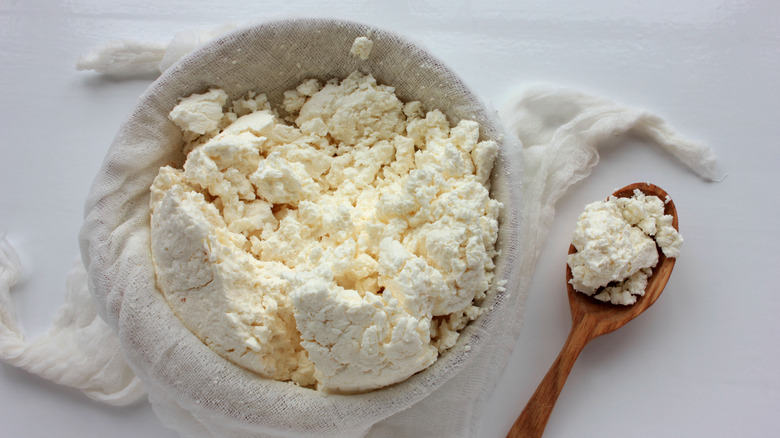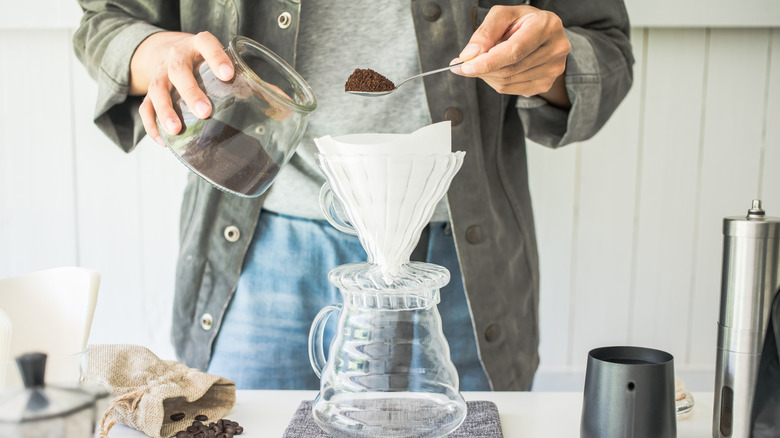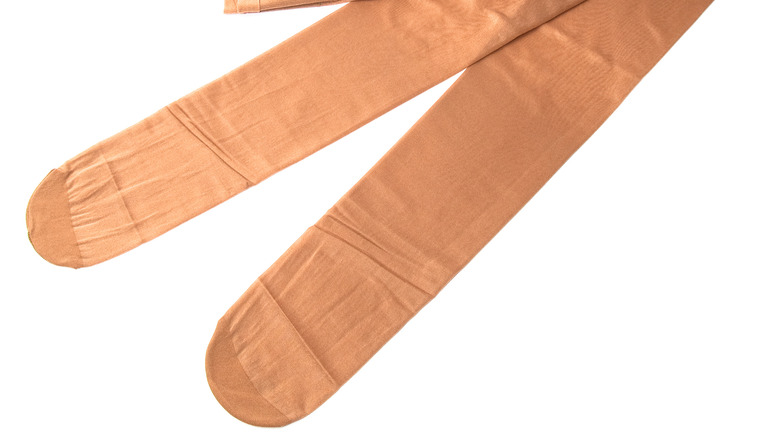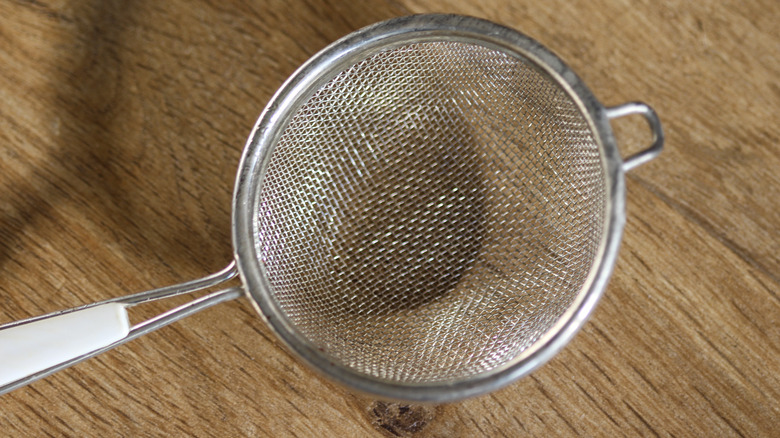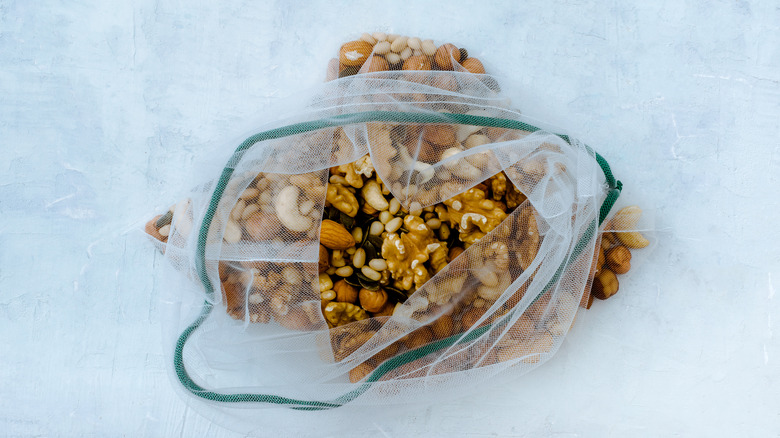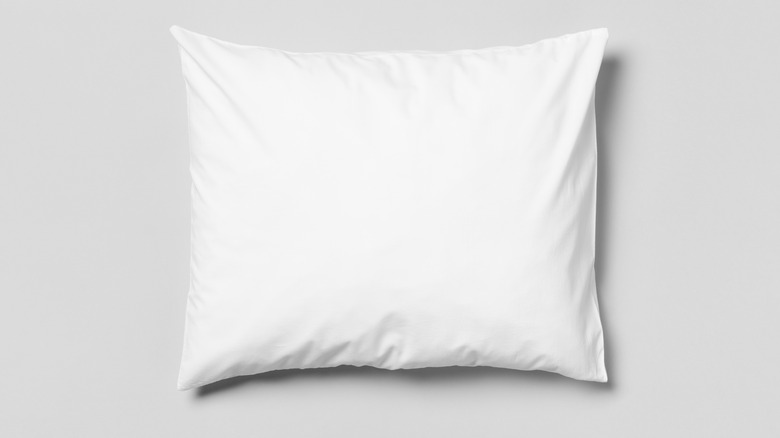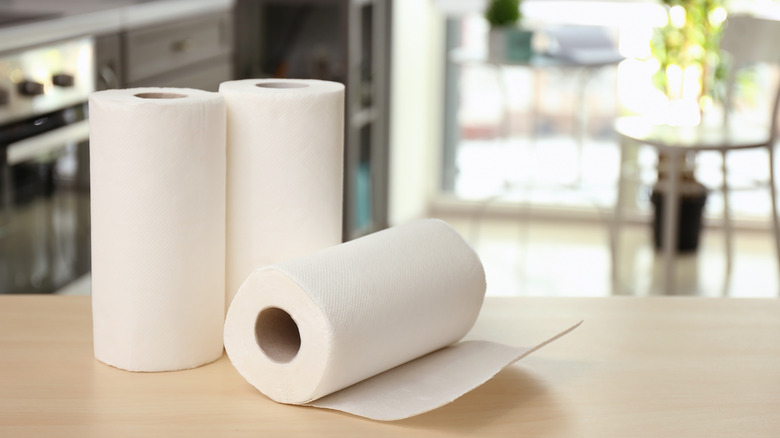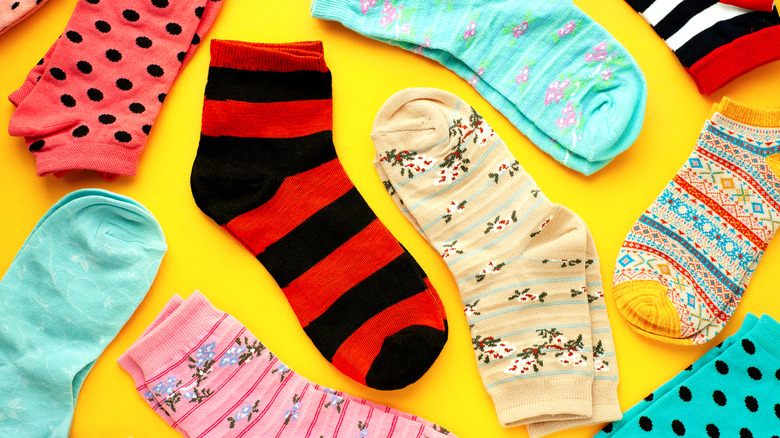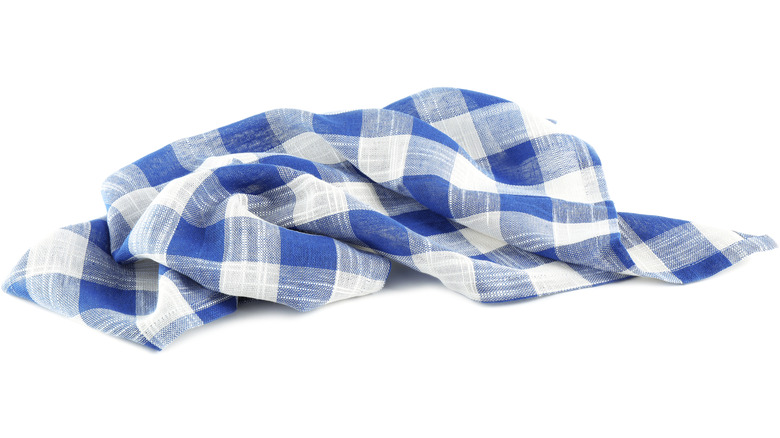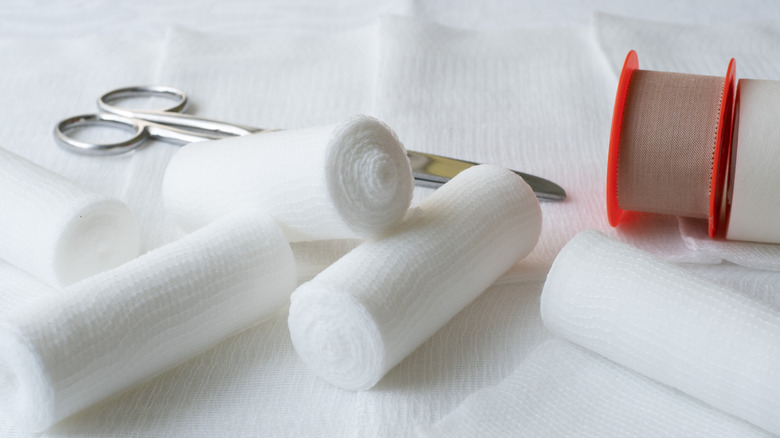10 Best Substitutes For Cheesecloth
Even if you've never tried to make homemade cheese, there's a chance you've encountered some type of recipe that calls for cheesecloth. The unique gauze-like cotton can be absolutely essential in the process of creating certain dishes. Whether you're straining out blended nuts to create your own creamy cashew milk or almond milk, crafting a little herb pouch to place in soups, or using it as a way to keep the meat you're roasting moist, cheesecloth has many uses in the kitchen. Unfortunately, it isn't always something every cook has on hand. Even if you once purchased a package of cheesecloth for a recipe, it's possible you tucked away the remaining material and forgotten exactly where you put it.
Not to worry, though — there are alternative items you may have lying around the house that will be just as effective. While you may need to make some adjustments or do a little extra cleaning to ensure what you're using is ready for food preparation, there are a lot of options to explore. Here are 10 substitutes you can use in place of cheesecloth that will have you whipping up that recipe you've got your eye on in no time at all.
1. Coffee Filters
Given that coffee filters are capable of keeping your finely ground coffee out of your morning brew, it makes sense that they would work well when it comes to straining out whatever you don't want in your recipe. The material making up coffee filters typically has a relatively tight weave, which means it will effectively strain out even the smallest of particles.
The one thing to note with this particular substitute is that you'll want to be patient — if you pour a gallon of soup through a coffee filter all at once, you'll overwhelm it and it'll just become a soggy mess. For best results, via Leaf, place the filter over whatever container you're going to strain your recipe into, and then ladle it in bit by bit. The process may be a bit slower than when you use a cheesecloth, but it'll get the job done. Coffee filters are also readily available, so even if you're a devoted Nespresso or Keurig user with no filters in the house, you can easily find them in stores. If you're looking for a more eco-friendly solution, you can also use the reusable filter within your coffee machine — you'll just want to make sure to clean it very well afterwards.
2. Pantyhose or thin tights
Anyone who has worn pantyhose or tights at some point knows the frustration of getting a run in a pair, rendering them virtually useless for wearing. However, don't throw them out just yet! Instead, consider saving them for use in your kitchen.
While it may seem odd, pantyhose and thin tights with a low denier have a very fine weave that is perfectly suited for straining out anything in your dish (although obviously, you'll want to make sure they're laundered and clean before using for any kitchen purposes). If you're straining large amounts of liquids, The Spruce Eats shares you can stretch a segment of the pantyhose or tights over a mixing bowl. For smaller tasks, like creating a bouquet garni (aka those little pouches filled with whole spices or herbs that you'll want removed from your dish before serving), you can use the foot portion to easily create a pouch. As an added bonus, this is a very eco-friendly solution — wash your DIY cheesecloth substitute and reuse it as many times as you'd like.
3. Fine Wire Sieve
While something with larger holes like a colander isn't quite suited to the same type of tasks that cheesecloth would be used for, a fine wire sieve can be a decent substitute in certain situations. Depending on the size of your sieve, this can be a user-friendly replacement, as you may be able to brace it against a the edges of your container while straining.
The one downside to using a sieve, as Kitchen Community explains, is that it doesn't filter at quite the same level cheesecloth does. In certain dishes this may not be an issue, but if your recipe depends on every little particle being filtered out, you may want to look for another substitute. As with many of the other alternatives available, this is an eco-friendly option that can be reused time and time again without much effort.
4. Fine Mesh Bag
While you may not have any cheesecloth, there's a good chance you have a fine mesh bag. Perhaps you have one in the kitchen already, which you primarily use to strain nutty pulp when creating your own non-dairy milk. Or, maybe you have a fine mesh bag in your laundry room that you use to keep your delicates protected in the wash. Finally, any DIY enthusiast may have a paint strainer bag on hand, which can be used for the same purposes as cheesecloth (although you'll obviously want to ensure it's properly cleaned before using it).
Whatever the original purpose for your fine mesh bag, it can be very useful for cooking. According to The Kitchn, not only does it serve as an ideal substitute for cheesecloth, it may even be preferred because of how much easier it is to clean and how much longer it will last. Unlike cheesecloth, which can't really be reused effectively, you can strain your recipe with the same bag again and again. We love an eco-friendly substitute whenever possible, and this one definitely delivers.
5. Clean Pillowcase
Even if you're not much of a cook, chances are you at least have a few spare pillowcases in your home. While you don't want to use your favorite pillowcase for culinary purposes, if you have an extra that just sits in your linen closet taking up space, you may just have found the perfect use for it — as a substitute for cheesecloth.
All you need to do for this particular alternative is secure the pillowcase over a bowl and vessel so that the fabric is pulled taut. This creates a filter of sorts for whatever you're trying to pass through. Then, when you're done straining, you can simply rinse the pillowcase out in the sink to get rid of any remaining particles before tossing it in the washer for a proper cleaning. The one thing to note with this substitute, says The Spruce Eats, is that this pillowcase may become one reserved for culinary purposes, as the food you're straining can leave stains behind.
6. Paper towels
Unless you've switched entirely to reusable kitchen linens, there's a good chance you have a roll of paper towels somewhere in the house, whether you use it for wiping up spills or cleaning mirrors. Paper towels can also make a decent substitute for cheesecloth when you find yourself without the latter, but there are a few considerations.
First of all, Cooking Chew explains that paper towels are fairly delicate, which means you'll need to be a bit more careful when straining to ensure your paper towel doesn't disintegrate. You'll need a brand of paper towels that is a bit stronger, with multiple layers per sheet, not the thinnest available option on the market. You should also be aware that the paper towel itself will absorb some of the liquid of whatever you're straining (after all, that's what they're designed to do!), so you may want to factor that loss into your recipe. The one major benefit of this substitute is that paper towels are extremely accessible — you can find them just about anywhere, from grocery stores to gas stations.
7. Socks
While your dresser drawers may not be the first place you look when it comes to finding kitchen substitutes, there's actually one thing that you may find works well as a stand in for cheesecloth — socks! As with anything being used for food preparation, you obviously want to ensure the socks are freshly laundered or new before using them for this purpose. Tastessence explains that the thin cotton that makes up most socks (we're talking about your everyday pairs, not the thickest wool socks you rock in the winter chill) is actually well-suited for straining.
If you're straining a large volume of liquid, you can stretch the sock fabric over a vessel and use it as a filter. Or, if you're straining a smaller amount, you can simply take advantage of the natural pouch the shape of a sock creates. For those trying to make their kitchen as eco-friendly as possible, this is another substitute that can easily be washed and reused.
8. Cotton Kitchen Towels
You know those kitchen towels you have hanging over the handle on your stove or dishwasher, or tossed up on a hook near your oven? Well, those can be used for everything from wiping up spills to drying dishes. And, as it turns out, they also make a great substitute for cheesecloth. The Kitchen Community shares they're typically crafted from a thin material with a tight weave, meaning they'll help you strain out even the smallest particles.
To use, secure the towel with an elastic band over a bowl or vessel of some sort to create a taut "filter" to pour your liquid through. The one thing to be aware of is the potential for stains — you're better off reaching for an older kitchen towel you don't use much anymore, and leaving the crisp, white option on display, as what you're straining through the towel could likely stain the material.
9. Muslin
Not only is muslin a fantastic substitute for cheesecloth, but according to Viet World Kitchen, in some cases it can actually be an even better implement for your kitchen needs than cheesecloth. For those who may not be familiar, muslin is simply a thin, lightweight, plain weave cotton fabric with many uses. Whether you're an enthusiastic crafter or a new parent swaddling your baby, if you have this breezy fabric on hand, you can certainly use it in place of cheesecloth.
Muslin typically comes in swaths, like any other fabric, so you may need to create a flat surface by placing the muslin atop a container or vessel and securing it with a band of some sort. Then, you'll be able to easily pour whatever you're straining through the material. One of the perks of muslin is that it's very inexpensive and can be easily torn to create the size of fabric you need. And, a fact many cooks interested in sustainability will love, it can be reused over and over.
10. Medical Gauze
If you've ever looked at cheesecloth and thought of how closely it resembles medical gauze, well, you're right — the two have many similarities, making medical gauze a solid substitute. As an added bonus, most home first aid kits come with gauze, so there's a good chance you have some of this material laying around (although you'll of course want to replace the gauze in your medical kit as soon as possible, in case it's needed!).
The one important thing to consider with this substitute is the weave — medical gauze is typically thinner than cheesecloth, so you'll have to create a thicker piece of fabric by layering several pieces of gauze. This also helps to address the fact that medical gauze has a looser weave — you'll want those layers to ensure you're managing to strain things out. (Cooking Chew suggests using about three to four layers.) The one downside to this particular substitute is that, like cheesecloth, it's not exactly eco-friendly. Once you use the gauze, you should throw it out, as it can't be used effectively a second time.
